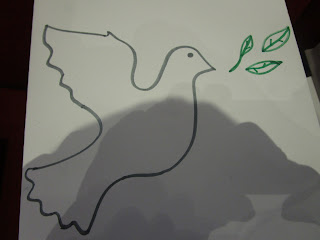Yesterday morning, the fifth grade workshop focused on the Siddur (the Jewish prayer book).
 |
| Families began arriving around 8:45 a.m. and continued arriving until a bit after 9 a.m. What a wonderful surprise to see so many families participating in the workshop! |
 |
| There were bagels, cream cheese, coffee and tea waiting for them when they arrived (but only after each family registered and made a name tag for each member!). |
 |
| Soon after everyone had arrived, Rabbi Shanks welcomed the group and introduced the subject of the workshop - the Siddur! |
 |
| Here we are performing the skit. |
Charna:
Look at all the people sitting here. What’s going on?
Ella T.:
We’re having a siddur celebration!
Charna:
A celebration? Fantastic! But what’s a siddur?
Maimone:
It’s the Jewish prayer book.
Kyra:
That’s a funny name for a prayer book.
Does it mean anything?
Maimone’s
TA: It’s a Hebrew word, which means “order.”
Charna:
What does that have to do with a prayer book?
Ella T.:
When we get together to pray, we say each prayer in a special
order. The prayer book – the Siddur –
makes sure we know what that order is. That way, it doesn’t matter if you’re a
Jew living in India or Tunisia or Switzerland or the United States. We all say
the prayers in the same order.
Charna:
That makes sense. So how are you planning
to celebrate the Siddur today?
Maimone:
Each of the fifth graders at Temple Isaiah is going to be presented with
his or her own siddur, which they’ll use to help prepare for their Bar and Bat
Mitzvah ceremonies, and hopefully for many years to come.
Charna:
Wow – that’s a really nice gift.
Can they put their names in the Siddur?
Kyra:
Better yet – we’ll give them a chance to decorate the Siddur – we call
that part of our celebration “Hiddur Siddur.”
Charna:
Nice name – what does it mean?
Ella T.:
“Hiddur” means to decorate or to embellish. Rabbi Ishmael in the Talmud
remembered the Biblical verse from the Book of Exodus, “This is my God and I
will glorify Him.”
Kyra:
That’s right. At first, it didn’t
make much sense to him – after all, how can human beings add glory to the
Creator?
Maimone:
After mulling the problem over for some time, he suddenly had an “AHA”
moment.
Ella T.:
“AHA,” he said to himself. We can
glorify God in the way we perform God’s commandments – the mitzvot.
Maimone:
When God commands us to celebrate Sukkot, we can make a beautiful lulav
and sukkah. When we celebrate Rosh
Ha’Shana as God commanded, we can use a beautiful shofar.
Kyra:
The Talmud tells us that we should make a beautiful Torah scroll which
has been written by a skilled scribe with fine ink and fine pen and dressed
beautifully.
Ella T.:
And of course, when we pray, we can do so using a beautifully decorated
siddur.
Maimone:
So today we’ll have a “Hiddur Siddur” half hour, when the students and
their parents can work together to create a beautiful book jacket to cover the
siddur, to help glorify God.
Kyra:
The students will use their beautifully decorated siddurim during our
week day tefillah sessions, so they’ll keep them at school until the end of seventh
grade.
Ella T.:
After that, we hope they will become heirlooms, to pass down to future
generations in the family.
Maimone:
Most importantly, we hope they’ll be used lovingly, and not just kept on
a bookshelf after the Bar or Bat Mitzvah ceremony.
Charna:
So what are we waiting for? Let
the celebration begin!
 |
| At this point, everyone got up from their seats and divided up, immediately taking materials and tools and discussing ideas for decorating the covers. |
 |
| The covers were quickly placed on each student's siddur, and there were lots of happy faces posing for proud parents. |
Our Edot students can be very proud of the covers they designed for their Siddurim:
Meanwhile, in the Oneg Room, Maimone had an interesting game called "Human Battleship" that he introduced to the students: (We discovered soon after he began to introduce the game that the microphone that Rabbi Shanks was using in the Social Hall was connected to a speaker in the Oneg Room, so the voice that Maimone is reacting to in the video below is that of Rabbi Shanks next door.)
We finished the game, and Rabbi Shanks and Michaela finished their presentations just in time for all the families to join us at our regular Sunday tefillah in the Sanctuary, led by Rabbi Greninger and Ben.
 |
| It was a wonderful opportunity for the students to use their new Siddurim for the first time. |
















No comments:
Post a Comment